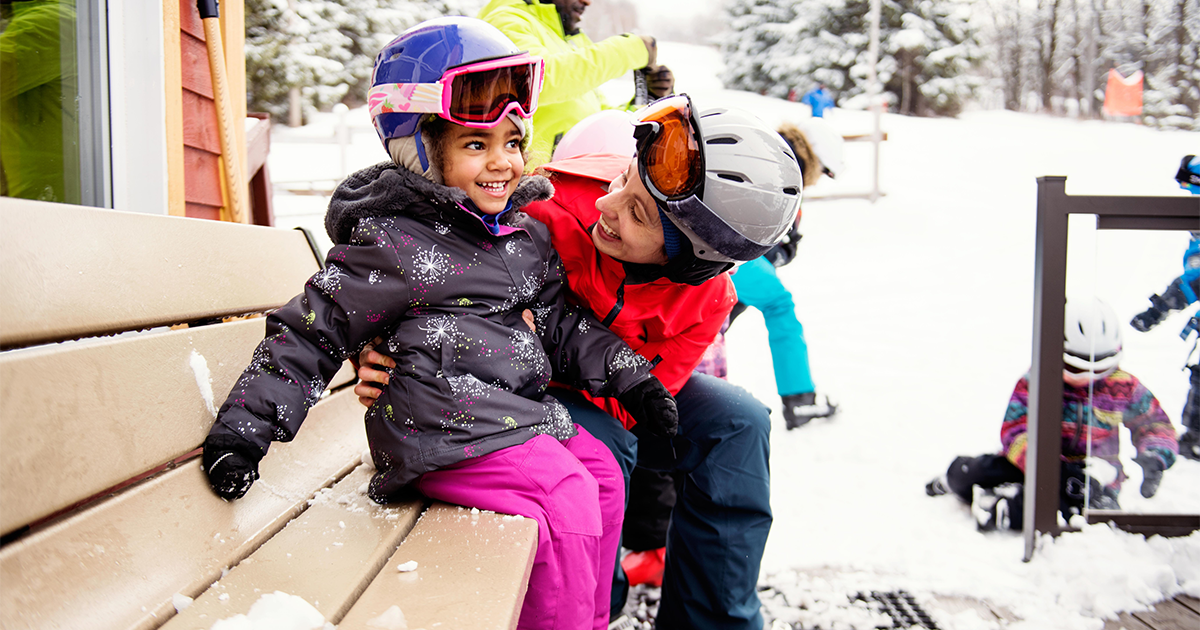Many kids would rather be outside and active than stuck indoors. And, many Minnesotans love to take advantage of the snow and spend their days skiing and snowboarding. We’re sharing some tips on how to prepare your kids to stay safe when they hit the slopes, whether they’re novices or experts.
Why is safety so important?
These sports involve going down steep hills at very high speeds. These hills can also be crowded with other skiers and snowboarders, trees and foliage, or other manmade obstacles like jumps. Falls and collisions can and do happen, even to experienced skiers and snowboarders!
Falls can sometimes be gentle and your child can get back up and continue on their way down the hill. But falls can be more serious, especially when it results in a head injury. Head or spine injuries can be dangerous and sometimes even deadly. Collisions with objects or other people can also cause serious injuries, so it’s important for skiers and snowboarders to always look where they’re going and be careful to avoid collisions. Thousands of kids and teens end up in the emergency room with similar injuries each year.
What kind of gear do kids need to ski or snowboard?
Before kids head out to the slopes, it’s important for them to have the right gear and understand how to use it. In addition to skiing- and snowboarding-specific gear, children should bundle up in warm, waterproof clothing to protect from frostbite or hypothermia.
Winter gear
Not wearing the right clothes under your gear can really ruin the fun! This is why it’s so important to dress kids in layers so they can adjust for the changing temperatures on the slopes. Here’s a rundown on what types of clothing kids should wear:

- Thermal underwear and socks.
- Intermediate layers like fleeces or wool sweaters.
- Ski pants that allow kids to move freely.
- Wind-proof and water-resistant jackets.
- Neck gaiters.
- Hats.
- Gloves or mittens.
- Hand and boot warmers.
- Sunscreen and lip balm
Be smart on the slopes
After kids have all of the gear they need to ski or snowboard, there are a few more safety tips they can follow on their own.
Enjoy the hills with a friend
No matter how good they are, it’s possible for kids to have a bad fall and be unable to continue skiing or snowboarding. Having a friend to look out for them and, if necessary, summon the ski patrol is much safer than going out on the hills alone.
Know their limits
Make sure your kids are aware of and honest about their ability. If they’re beginners, have them stick to the beginner slopes until they feel comfortable enough to move up to something a little steeper. Most trails are clearly marked as green circles (beginner terrain), blue squares (intermediate terrain), or black diamonds (advanced terrain). If a trail says it’s for experts only, it means just that. Terrain that is beyond their ability is not only no fun, it’s also a good way for them to hurt themselves.
Follow the rules
Insist that your kids know to never venture past the boundaries or go into a closed area. These areas are off-limits for a reason. They’re not patrolled by the ski patrol, and they usually contain hazards that your kids don’t want to deal with, like fallen trees or large branches. Also, make sure they pay attention to any warning signs they might see. If a sign says, “Slow skiing area,” they’ll want to go slow to avoid others on the hill. If a sign says, “Cliff,” they’ll want to go another way or stop before they go over the edge.
Practice skier and snowboarder etiquette
Kids need to remember that people in front of them or below them on the trail have the right of way. Tell them to never stop in the middle of a trail or anywhere where they can’t be seen from above, such as below a drop off. They should also look uphill to make sure no one is coming toward them before they start down a trail or merge onto a new trail. If they’re passing another person on a catwalk or narrow trail, have them call out “on your right” or “on your left” to let people know they’re approaching.
Know a snowboarder’s blind spot
One major difference between snowboarding and skiing is that kids will be facing sideways when they snowboard, creating a blind spot behind them. Let them know that they should always be aware of who or what is around them at all times. This is particularly important for beginner snowboarders. It can be hard for them to take their focus off the slope ahead to make sure it’s safe to turn, but it is vital that they make the effort each and every time they do.
At Children’s Minnesota, we love seeing kids. But we know they would rather be having fun than at the doctor, and we would rather see them safe at home too! These tips will help keep your kids safe and healthy while enjoying winter activities.
Level I pediatric trauma center
Children’s is home to the only Level I pediatric trauma center in a hospital dedicated solely to kids. This means that we are equipped to handle the worst-of-the-worst injuries and traumas, allowing us to provide the highest level of care for critically injured patients 24 hours a day, 365 days a year.